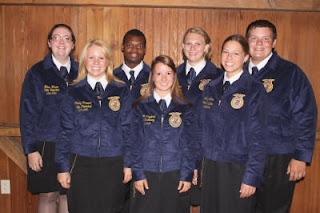Part 2: Reflection on Summer Reading
My insight on the book Teaching Outside the Box: How to Grab Your Students By Their Brains by Louanne Johnson
I loved reading part 2 which encompasses chapters 5 through 8. The instruction and suggestions provided are areas in which I know I had many questions and I will definitely try to implement her ideas into my teaching. I will share a few highlights from part 2 below.
Start with a smile and greet at the door
This idea seems pretty standard to me (and for someone like myself who smiles a lot anyway, you wouldn't think this would be one of my highlights). BUT I smile because I think it's important, and I know a smile can go a long way. As I design my classroom to a place where I establish comfort and rapport, smiling is one of the small and free ways to do that. I believe this goes hand in hand with standing at the door and many other small gestures that show students you care. Being able to greet students as they enter the classroom is a goal I hope to do as much as I can, if not, every day.
Grab your students by their brains
 |
| blog.emilysuess.com |
This is the title of the section for the second highlight I wish to share. The author explains the science behind a surprised brain and how if students are surprised, they are "more likely, biologically, to follow the suggestion". I thought this was really interesting. It reminds me of something I had learned from the session for National Teach Ag Day when Dave Burgess spoke at Penn State. He used an excellent example of a "gift" that had arrived in his classroom. He continued to unwrap it very slowly, not giving the students the immediate satisfaction of knowing what this object was. When he finally pulled it out of it's wrapping, it wasn't what the students expected at all. In fact, to them, it was very random and weird... It was a burned bra! He used this to speak about the women suffrage in history. Once he explained why he was showing it to them, the light bulb lit up. They understood this connection to the mystery object, and were most likely able to remember that lesson better than anything else that day because of how peculiar it was.
Groups that laugh together, cooperate better
| thehealthnut.com.au |
Comedy is not one of my strong suits. Sure I generally have a good sense of humor and enjoy laughing a ton, but to make others laugh... that's where I fall short. However, Johnson says that "groups that laugh together develop a quick rapport, and they tend to cooperate more quickly and efficiently". I want to be able to provide an outlet for my students to enjoy themselves and laugh. However I recognize my specific skill set may not allow them to do this. Instead, I will try to incorporate videos, pictures, stories, and small group discussions where I can get them laughing with me instead of at my cheesy and most likely lame jokes. I mean, if there are some students that like lame jokes then I'd be perfect for the job. But I'll let the professionals do the talking and the students do the laughing.
Minding your manners
In my book, I specifically circled this section about gratitude. Johnson says to always say thank you to your students. It might sound a little over done, but I think students need to hear that they are appreciated. More than this, she assures readers that by thanking good behavior, students have an example of what they need to do to earn respect and receive a "thank you" as well. It's not tricking your students. It's showing that good behavior does not go unnoticed.
Discipline and Rules
Johnson brought up some really good tips for one of my most dreaded responsibilities--disciplining students that are misbehaving. I hope and pray that I will never have to ever do it, but I'm realistic enough to know that it's inevitable. I'll simplify her philosophy on discipline. Basically, she believes that instead of yelling, embarrassing, blatantly ignoring, or whisking students away when they misbehave, a teacher must be firm but show care. She suggests pulling students aside and
- Make the student accept responsibility
- Allow the student to back down gracefully (don't put them in a hard place where they are forced to fight back to save face)
- Seek solutions instead of assigning consequences
- State your expectations for future behavior
- Don't hesitate to give positive feedback when behavior improves
- Wipe the student's slate clean (if the problem is resolved, don't hold it against them. Show them that you believe they can change and they will)
| enlawyers.com |
When all else fails, she says that teachers should step out of their room to cool off and have another teacher or staff come and watch the classroom. Alternatively, have the student sit outside the classroom to cool off and think. Johnson says that as a last resort, send them to the principals office. But it's better to resolve the problem within the classroom unless it's something serious that needs administration attention. Even if you don't send the student to the office, though, you can still talk to the administration to seek help if you are struggling.
One final note on discipline that caught my attention. She also mentioned to call the student directly, as in by telephone. A story she shared was her intent to call the parents about the behavior but when the student picked up the phone, Johnson spoke directly to her student. From then on, she noticed a change in that student's behavior. She senses that it is because the student doesn't have an audience and the teacher and the student can have a private conversation about the issue as adults. I may have to try this!
Reading and Lighting
The final two chapters in part 2 talk specifically about reading and lighting problems. To summarize, these two seeming small things can cause huge issues for students.
Students who struggle to read usually do not like to read in front of other students and will avoid doing so at all costs. Johnson stresses that instead of forcing this student to read, let them volunteer when they are ready, if at all. Like a turtle coming out of it's shell, let them do so when they feel most comfortable and feel they will not be judged. Instead of having them worry the entire class knowing they have to read only to not retain anything from the reading, let them just listen and give them that opportunity to absorb. Letting them do this at their own pace doesn't make them lazy or bad students. It just means they may take a little longer to understand or feel ready to participate in readings.
| groupon.com |
Additionally, poor lighting can cause issues. Not even poor lighting, necessarily but florescent lighting can be irritating to some student's eyes. Johnson suggests allowing students to read by natural light. Some students also cannot read on the harsh contrast of black and white paper because it makes the words seem unclear. Although they may be tested and have 20/20 vision, those students may have a condition called Irlen syndrome. I can't articulate the exact science behind it, but Johnson speaks about it and explains that having a colored transparency to place over the page can do wonders for students eyes. Purple, blue, green, whichever color specific to that student's needs can mean the difference of reading at their grade-level pace or not.
One final note on time
Several times throughout the book, Johnson mentions slowing things down for the students. Some students are slow processors and know the answer but just need more time. I've often noticed this in myself growing up. I couldn't understand how students read a packet so quickly or how certain answers to open ended or complex questions came to them so quickly. Sometimes the answer was on the tip of my tongue. And if I wasn't confident in the subject area then jeopardy was a tough game for me. I get so anxious about getting to the answer quickly that I don't actually think about the question logically and often only skim the surface of the answer. If I had only had a few more seconds where I could think, I'm sure I would have gotten more things right. If I had had more time to take tests, I think I would have done better. If I had more time to read assigned readings, I think I would have saved myself the frustrations and struggles of comparing myself to other readers.
 |
| timeanddate.com |
I'm not diagnosed with anything that would suggest an issue. I don't say that to save face. I say that because if I never needed a diagnosis but still had minor struggles, I can't imagine how many students are like me that don't need the diagnosis but yearn for more time. Even harder for me to imagine, then, are the students that are diagnosed and fight every day for a few more seconds to grasp concepts.
Time is such as valuable resource, and sometimes, teachers need to spend a little more on their student's brains, for the students' sake, instead of rushing through to accommodate the teacher's own agenda. I hope that I will be able to do this for my students and recognize when they just need a little extra help and time.
Leaving Thought
"Everybody is a genius. But if you judge a fish on it's ability to climb a tree, it will live its whole life believing that it is stupid"--Albert Einstein
^p.s. this is my favorite quote so it will probably reappear many times ;)










